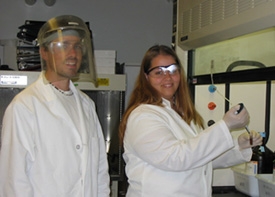
School:
Grade Level:
Teaching Position:
Supervisor:
Department:
Mentor:
Research Project Year:
Research Project Title:
Research Project Description:
Recent discoveries in Gene Therapy, such as RNA interference, have led to a greater pursuit of the understanding and development of highly efficient gene carriers. These carriers can be synthetic liposomes that package nucleic acids (DNA and RNA) into complexes which in turn, deliver the nucleic acids into cells. It is important to understand the mechanism for this deliver so that further development of synthetic liposomes can be tuned for greater efficiency and lower toxicity. We used a bioluminescent assays in conjunction with DNA dot blotting that helped delineate the difference seen between delivery efficiencies of a highly fusogenic complex (using a cationic lipid DOTAP and a fusogenic lipid DOPE) and a non-fusogenic complex(DOTAP with the non-fusogenic lipid DOPC). We observed that the fusogenic complex had a 10% increased in the amount of delivered DNA and, that this seemed to correlate with a 10 fold increase in the amount of bioluminescence when compared to the non-fusogenic complex. Future research will include the separation of nuclear and cytoplasmic fractions of delivered DNA to further the understanding of the mechanism for gene delivery by these complexes.
Research Project Attachments:
| Attachment | Size |
|---|---|
| 1.56 MB |
Curriculum Project Year:
Curriculum Project Title:
Curriculum Project Description:
After researching gene therapy I wanted to create biotechnology activities and labs that could be supplemented into a genetics unit. The activities include a genetic disorder poster highlighting how iRNA could cure the disease, a debate regarding the use of genetically modified foods, and a skit with a genetic counselor and a set of parents. The labs include DNA extraction from an animal and plant, DNA fingerprinting with a forensic twist, and Plant Tissue Differentiation (so students realize that you do not have to change the genetic makeup of an organism in order to change the gene expresssion). My hope is that these activities will show students how important both personally and politically genetics and biotechnology are NOW!
Curriculum Project Attachments:
| Attachment | Size |
|---|---|
| 3.89 MB | |
| 4.82 MB |
